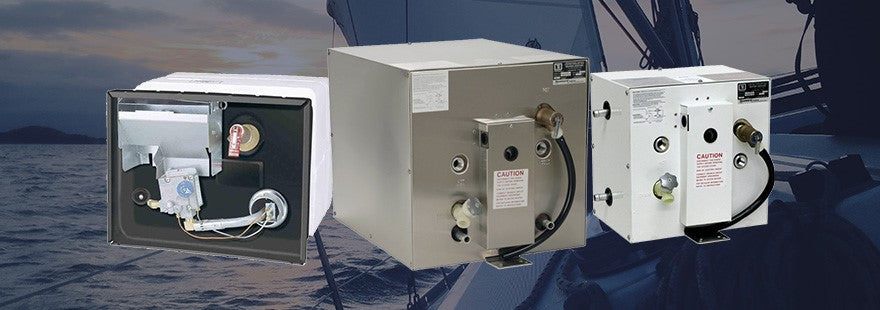How to Choose a Marine Water Heater
A marine water heater can often look quite similar to the one in your home. But in reality, it’s extremely different. These high-quality heating appliances utilize unique methods for heating your water and can work in very harsh and humid environments. But when it comes to replacing your current Atwood water heater, how do you find the heater that’s ideal for your specific watercraft?
If you’re replacing an older model, the easiest way to find the right boat water heater is to find the newer Whale/Attwood model that was created as a replacement for your current unit.
Find Your Marine Water Heater Replacement Model
If your current marine water heater model number is accessible, follow our easy-to-use chart below to quickly find which new Whale/Attwood water heater model is compatible with your current Atwood water heater model.
| Original Atwood Model | New Replacement Whale/Attwood Model |
|---|---|
| Atwood E20 | Whale/Attwood H2050EW |
| Atwood E20-220 | Whale/Attwood H2050EW |
| Atwood EH20 | Whale/Attwood HF2000 |
| Atwood EH20-220 | Whale/Attwood HF2050 |
| Atwood EHM4 | Whale/Attwood S300W |
| Atwood EHM4-220 | N/A |
| Atwood EHM6 | Whale/Attwood F600W |
| Atwood EHM6 SST | Whale/Attwood F700 |
| Atwood EHM6-220 | Whale/Attwood F650W |
| Atwood EHM6-220 SST | Whale/Attwood F750 |
| Atwood EHM6-240 FHX-AU | N/A |
| Atwood EHM11 | Whale/Attwood F1100W |
| Atwood EHM11 SST | Whale/Attwood F1200 |
| Atwood EHM11-220 | Whale/Attwood F1150W |
| Atwood EHM11-220 SST | Whale/Attwood F1250 |
| Atwood EHM11-240 FHX-AU | N/A |
| Atwood EHP10 | N/A |
Be sure to check the dimensions of the replacement models. While most Atwood water heater replacement models are designed to be small and lightweight, some may be sized differently from their predecessors.
If you’ve never had a marine water heater before, had a model other than the ones listed above or simply can’t locate your previous model number, keep reading to find the right marine hot water heater for your watercraft based on power source.
Powering Your Marine Water Heater
Nearly all marine hot water heater models operate using one of two methods: electricity or propane gas. An AC current from either of these sources is able to power a heating element that is immersed in water. The temperature is then established by a thermostat. But in addition to this power source, most onboard water heaters can also operate by using the boat engine’s wasted heat energy through the use of a heat exchanger. Let’s explore these available power options in order to find the right one for you.
Electric
An electric-powered boat water heater works by utilizing immersion heaters that are positioned in the lowest part of the tank where the water is the coldest and where the unit can utilize the maximum output from the heating element. When hooked up to shore power, most electric marine water heaters work on 110 V.
Note: Electric boat water heaters are typically set to temperatures above 131℉ in order to prevent the development of harmful bacteria in the water supply. When used, this hot water will mix with cold water. Because of this, setting your temperature to a higher setting will effectively make your hot water last longer.
Propane Gas
A propane marine water heater does not rely on electricity to run and depends strictly on the watercraft engine’s performance. These are incredibly reliable closed-combustion units that can typically be mounted anywhere inside the boat.
Heat Exchanger
Most propane gas and electric marine water heaters can also operate using heat from the in-use engine. Much like the one that cools your engine or generator, a heat exchanger works by transferring the heat that is generated from the engine’s closed cooling system to the water inside the water heater’s tank. So, instead of that heat going out with the exhaust and being wasted, it can be used to wash dishes or take showers.
Keep in mind that when the water is heated this way, the electric thermostat has no control over the temperature of the water, which can create a potentially dangerous scenario. In order to control the water temperature when using a heat exchanger, you should install a tempering valve at the heater or anti-scald valves at the faucets. These can easily be added to any water heater, however, not all are able to react quickly enough to prevent scalding. Because of this, certain protocols, including those from the manufacturer, should be followed.
- If the heat exchanger or any part of the plumbing between the marine water heater and the engine is located above the expansion-tank cap, a remote expansion tank needs to be plumbed into the system.
- This remote expansion tank then becomes the primary fill point for the closed cooling system. When a remote expansion tank is installed, it has to use the pressure cap specified by the engine manufacturer. The original cap on the engine then needs to replaced with a higher-rated cap. Be sure to check with the engine manufacturer for model-specific instructions.
- By taking this step, you’ll ensure that the cap with the highest elevation within the system (the one which can vent air) is the only one that opens and closes with temperature-induced pressure fluctuations.
Note: A marine water heater should be installed by a licensed professional.
Shop Boat & RV Accessories for Your New Marine Hot Water Heater
Boat & RV Accessories offers a wide selection of marine water heater models, inverter chargers and more. Browse our entire selection of boat accessories today. Have a question or need more information?

